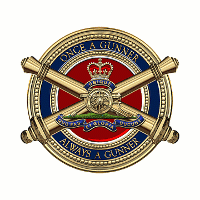Very little is known of Roy Harvey’s early life. We know he was born in Wimbledon, England on 21st November 1919. At the age of 20, Roy, who had at this stage immigrated to Australia, joined the Australian Army on 7 December 1939. His records show he was from the Manly locality and enlisted at Ingleburn. J. Harvey is listed as his next of kin and it is believed this was his father who was living in Hong Kong at the time. Roy listed his occupation on enlistment as “Electrical Engineer”. A conflict of historical records shows Roy taken on strength of the 2/1stt Field Regiment on 26 November 1939. Another document shows him granted the rank of “Gunner” on 10 February 1939 from which we could surmise that Roy had joined the Militia during 1938 or early 1939. Roy embarked for overseas service with the 2/1st Field Regiment on His Majesties Australian Troopship (HMAT) ‘U5’ leaving Sydney on 10 January 1940.
The Regiment was accompanying the 16th Brigade of the 6th Division. During the voyage, Roy was promoted to Lance Bombardier and he and the Regiment arrived in Kantar in Egypt on 13 February 1940. The Regiment then moved to Palestine and recommenced training. In June 1940 Roy was promoted to Bombardier. In June of that year the 2/1st Field Regiment moved to Haifa and commenced retraining as an Anti-aircraft regiment equipped with 40mm Bofors guns.
In late July of that year Roy was admitted to hospital with what appears to have been a serious injury to his left knee. He remained in various hospitals in both Egypt and Palestine until February 1941 so the injury may have been serious. On discharge from the 1st Convalescent Depot, he eventually re-joined his unit on the 3 March 1941. By late 1940 the 2/1st Field Regiment had relinquished the Bofors and had been issued with 25- Pounder guns and was in full training mode in preparation for action at Bardia in January of 1941. The Regiment was in support of the 6th Division for its advance towards Tobruk and Derna.
On 10th April 1941, Roy with the 2/1st embarked for service in Greece. With the remainder of the 6th Division, they disembarked in Greece in May 1941. Obviously, Roy was proving to be a very effective soldier and was promoted to Lance Sergeant on 21st May 1941. His promotion to Sergeant was later confirmed on 3rd December 1941. The Regiment was thrown into a difficult situation with the German advance pushing the 6th Division back towards Athens. The Regiment eventually was withdrawn to Crete leaving its Commanding Officer and some 70 members of the Regiment captured near Kalamata.
In December 1941 Roy was fortunate enough to be selected to attend the 1st Australian Corps Ski School. This three-week course would have been a far cry from the rigours of life at Suda Bay on Crete. In March of 1942, the 2/1st Field Regiment embarked from the Middle East on route to Ceylon. This was part of the reorganisation of Australian defences as a result of the Japanese threat to Australia. Roy finally disembarked in Brisbane in June 1942 but soon found himself with the Regiment in Port Moresby. The Regiment came under command of the Corps Commander Royal Artillery (CCRA – a term also used in the RAA). In April of 1943 Roy spent a month in hospital suffering from Malaria. The following month he departed Port Moresby and arrived in Townsville en route to attend a Gunnery Staff Course conducted by Land Headquarters at the School of Artillery. After the course, Roy re-joined his unit but was returned to the 113 Australian General Hospital (later Concord) when his Malaria returned. It also seems that Roy married Margaret while he was on course at the School of Artillery as his Next of Kin changed and he was recorded as Married on his service history.
By December 1942, Roy was promoted to Acting Warrant Officer Class Two (WO2) and in February 1944 attended further gunnery training at the School of Artillery. His first son Robert was borne in August 1944. In February 1945, Roy was posted to the School of Artillery as an instructor. His rank of WO2 was confirmed on 12 February 1945. Roy elected discharge on the 7 September 1945.
Roy’s second stint with the Australian Army began on 16 November 1950 when he was taken on strength as a Platoon Sergeant and allotted to the RAA. He gave his occupation then as “Manager – Aboriginal Station”. This was a position governed by the then NSW Public Service Board. By this time, he and Margaret had three children. Roy’s first posting in his second stint with the Army was to the 12th National Service Training Battalion which was raised in November 1950 and based at Holsworthy. This was a result of the Commonwealth Government introducing National Service and the need for more training establishments. Roy was allocated as an Assistant Instructor but remained attached to 1st Field Regiment, then based at Georges Heights. In early 1951, Roy attended and qualified “B” on the 3/51 National Service RAA Group 11 Instructors Course. On 12th August 1952 he “Commenced to perform the full duties of Pl (Platoon) Comd (Commander) (Lt)” at 12th National Service Training Battalion. Margaret and family had at this stage moved to live in the Holsworthy Village.
In February/March 1953 Roy attended the 14/53 ARA Officer Qualifying Course Special at the School of Infantry. This course was designed by the Directorate of Military Training for NCOs over the age of 23 to become officers. Such was the shortage of officers in the ARA at the time. On 17th May 1953 Roy Harvey became Lieutenant Roy Harvey. His first posting was to 1st Field Regiment at Georges Heights. In May of that year, Roy was back in hospital at RGH Concord for seven days but later in the year he was receiving Higher Duties Allowance (HDA) for Captain as a Troop Commander in 1st Field Regiment. In mid-1954, Roy attended the Number 29 Intermediate Course at the School of Land Air Warfare before returning to his Troop Commander duties on 10th July 1954. His malaria may have been playing up as he spent another two weeks in hospital at RGH Concord in September that year.
In May 1955, Roy was posted back to 12th National Service Training Battalion and in June 1955 he assumed the role of Company Commander. Roy may have had a hint of future postings because his family moved to a Married Quarter at North Head in April 1956. Roy was then posted to the School of Artillery at North Head on 24th June 1956. Here, Roy was promoted to Temporary Captain and performed the duties of Adjutant. In late 1956 he qualified on the 6/56 ARA Officers Observation of Fire Course. In April 1957, his promotion to Captain was confirmed. In April 1958 his Short Service (SS) Commission was extended until 10 April 1963.
In January 1960, Roy was posted to 3rd Field Regiment in Karrakatta, Western Australia. Roy and his family remained in the West for two years before a return posting to 1st Field Regiment. In June 1962 Roy was promoted to Temporary Major and appointed Battery Commander of 102nd Field Battery. Another move for his family now saw them living in Ingleburn. This promotion was confirmed in April 1963. During his time with 1st Field Regiment, Roy became acting Commanding Officer with HDA for Lieutenant Colonel. 1964 saw yet another move for the Harvey family when they moved back to a married quarter at North Head. Roy was to spend his final years in the Army posted to the School of Artillery. He elected discharge on 21st November 1966 after a 16-year stint in his second Army Career. He remained at the School of Artillery as a Retired Officer in the appointment of Senior Instructor Development Wing.
In 1986 the RAA Historical Society published the "The Guns of Middle Head and Georges Heights" which was researched and edited by Major Roy Harvey (RL). Roy was a member of the Society, and his book sets out a brief history of the defence of Sydney Cove from 1788 to 1961 when all Coast Artillery installations were declared obsolete
Acknowledgements
- Most information obtained from notes and papers of the late Arthur Burke.
- George Salmon for his input and advice.
- ‘The Gunners’ by David Horner.
- Gunfire Volume 18 Number 1 for information re “The Guns of Middle Head and Georges Heights”
|


